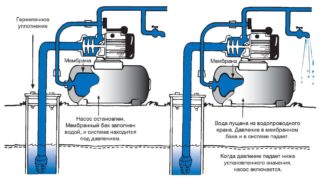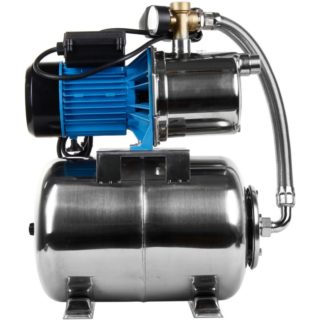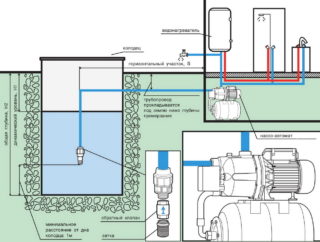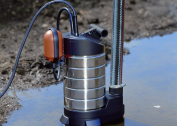The arrangement of a private house begins with the installation of communications. One of them is the plumbing and sewer. As a rule, pure water is supplied from a well or a well. In order for the water supply process to be uninterrupted, they resort to the installation of a pumping station. The complex allows you to provide the house with water around the clock and have its permanent supply. The device of the pumping station for domestic water supply is quite simple.
Purpose and principle of operation
The home pumping system is designed to lift water from a depth of 8 meters and supply it to all plumbing points in the cottage. The system works according to this principle:
- Installed between two sections of the pipeline and connected to a power outlet, the water unit pumps the liquid from the source into a special drive - a hydraulic accumulator.
- When the tank reaches a certain pressure, the pump turns off. Water reserve is made.
- As soon as the user opens the tap in the house, the fluid enters the desired plumbing point.
- At the same time, pressure drops in the accumulator and the on-off relay is activated. The pump again replenishes the water in the tank, and then turns off.
Station operation cycles are constantly repeated due to pressure drops in the tank.
The main elements of a home pumping station
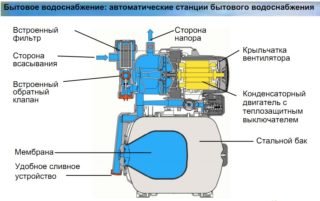 The work of a pumping station for a private house is based on its main elements:
The work of a pumping station for a private house is based on its main elements:
- pump - surface or submersible depending on the model of the unit;
- storage tank - it is also a hydraulic accumulator or hydraulic tank;
- filters - they are put on their own, because the elements are not included in the package;
- automatic control unit;
- non-return valve, responsible for the timely supply of water to the house with increasing pressure in the tank.
Installing filters allows you to protect all the working elements of the equipment from malfunctions in the presence of fine suspensions in the water: sand, clay, etc.
Types and classification
Distinguish all pumping systems for private use in several categories. By type of suction, there are two types of equipment:
- With integrated ejector. Designed for lifting and transporting water into the house from a depth of 8 meters. The model is relevant for installation on a well. Work stations with a built-in ejector is very loud. They are best installed in a special caisson, and not in the house.
- With remote ejector. Equipment capable of lifting water from a depth of 8 to 50 meters. Ideal for use with a well. It is quiet.
By type of stock and water supply:
- Equipment with a separately installed tank. Provides a constant supply of water. The tank takes up a lot of space and there is a risk of flooding the premises in the event of a malfunction with the drive. With a small pressure of water, the tank does not work, you have to put an additional booster pump.
- Hydraulic station. The filling of the tank is controlled by the battery and the membrane (usually in the context of the diagram it often looks like a diaphragm). The tank has compact dimensions. The actual use of hydraulic equipment with a small depth of water rise.
It is believed that the reservoir of the hydraulic station is more reliable.
By the type of pump, such systems are distinguished:
- Submersible. The unit is deepened in water. Experts believe that this type of equipment is more durable and easy to install, maintain.
- Superficial.The pump is located on land. The intake pipe is lowered into the source. Surface pumps have a simpler control system.
There are also special well and well stations. The former have a more powerful submersible centrifugal pump, which is demanding on water quality. Well equipment withstands the presence of impurities in it.
How to choose a pumping station
When choosing pumping equipment for a private house, you need to be guided by such criteria:
- Power. It is important not to go too far. Too strong equipment drains the source and hits its pocket. A weak station will not provide a supply of water for the house. The average power indicator of equipment for private use is 900-1500 watts.
- Depth of absorption of water. Some models are able to pump water only from a level of up to 8 m - meaning the distance from the surface of the earth to the liquid mirror in the source.
- Tank volume. For a family of 3-4 people, a capacity of 25-50 liters will be enough.
- The presence of additional protection. Many models are equipped with overheating systems. They prevent damage to the pump in the event of a drop in the water level in the source.
- Pump housing material. Optimum is considered plastic. It dampens noise, is durable and environmentally friendly.
The list of selection criteria includes the equipment manufacturer. Popular are considered to be "Gileks", Metabo, Pedrollo (Pedrollo), Grundfos (Grundfos) and Gardena. Good equipment cannot have a small price. On average, the pump system will have to pay from $ 500
Installation steps
Installation of equipment for pumping water from a well / well takes place in several stages:
- A fully assembled system is equipped with filters.
- Connect the unit to the suction line and be sure to monitor the grounding.
- Fill the membrane tank and the system with water, adjust the pressure switch.
- Turn on the pump station.
To damp vibrations under the equipment you need to lay a special anti-vibration pad. The room or caisson for the installation of the station needs to be insulated so that in winter the water in the tank does not freeze.
Important points in maintenance and operation
The basic principles of the system operation allow extending its service life and avoiding complex repairs. They are summarized as follows:
- The room, the caisson and the pipeline to the pump and after it must be insulated, otherwise the water will freeze in the system in winter.
- If it is not intended to stay in the house in winter, water from the tank and the pipeline must be drained before the onset of frost.
- Regularly (once a month and after each preservation of the system), it is necessary to check the correct operation of the pressure switch.
- It is important to clean the coarse filters regularly. The frequency of the operation depends on the degree of contamination of the water in the source.
If the filter becomes clogged, this will cause the pump to run idle; equipment may burn out.
Advantages and disadvantages of pumping stations
The main positive aspects of the pumping station are:
- ease of installation and operation: systems are delivered pre-assembled;
- providing a private house with uninterrupted water supply in an autonomous mode;
- protection of equipment from overheating and idling;
- moderate noise in operation, which is suppressed by the correct arrangement of the system; some types of equipment generally operate silently;
- long service life provided that the unit is used correctly.
Relative disadvantages include the cost of pumping equipment and the need for preliminary settings before starting.
Cost of pumping stations
The price of a water pumping station for a private house varies depending on the manufacturer, capacity, and the volume of the storage tank. On average, in Moscow and the region for low-performance models they ask from 2,000-3,000 rubles. More powerful models will cost an order of magnitude more expensive - from 4,000 to 10,000 rubles.If we are talking about a complex multistage station with strong technical characteristics, the price for it will start from 15,000 rubles and above. How much to pay for a reliable model of the unit, the master decides, depending on the needs of the family and budget.
The installation of a pumping station in a suburban area eliminates problems with the smooth operation of a well or well. Living in a country cottage as a result becomes no less comfortable than in a city apartment. If you have your own sewage system, you do not have to pay for wastewater.
